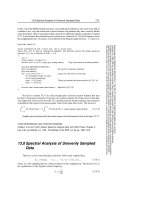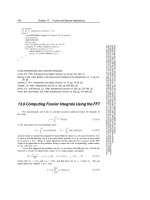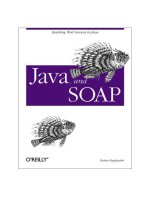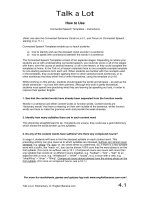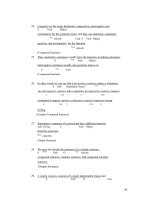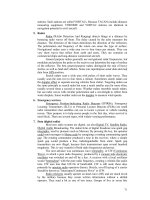Tài liệu Fourier and Spectral Applications part 6 doc
Bạn đang xem bản rút gọn của tài liệu. Xem và tải ngay bản đầy đủ của tài liệu tại đây (162.47 KB, 7 trang )
558
Chapter 13. Fourier and Spectral Applications
Sample page from NUMERICAL RECIPES IN C: THE ART OF SCIENTIFIC COMPUTING (ISBN 0-521-43108-5)
Copyright (C) 1988-1992 by Cambridge University Press.Programs Copyright (C) 1988-1992 by Numerical Recipes Software.
Permission is granted for internet users to make one paper copy for their own personal use. Further reproduction, or any copying of machine-
readable files (including this one) to any servercomputer, is strictly prohibited. To order Numerical Recipes books,diskettes, or CDROMs
visit website or call 1-800-872-7423 (North America only),or send email to (outside North America).
for (j=2;j<=m;j++) {
j2=j+j;
p[j] += (SQR(w1[j2])+SQR(w1[j2-1])
+SQR(w1[m44-j2])+SQR(w1[m43-j2]));
}
den += sumw;
}
den *= m4; Correct normalization.
for (j=1;j<=m;j++) p[j] /= den; Normalize the output.
free_vector(w2,1,m);
free_vector(w1,1,m4);
}
CITED REFERENCES AND FURTHER READING:
Oppenheim, A.V., and Schafer, R.W. 1989,
Discrete-Time Signal Processing
(Englewood Cliffs,
NJ: Prentice-Hall). [1]
Harris, F.J. 1978,
Proceedings of the IEEE
, vol. 66, pp. 51–83. [2]
Childers, D.G. (ed.) 1978,
Modern Spectrum Analysis
(New York: IEEE Press), paper by P.D.
Welch. [3]
Champeney, D.C. 1973,
Fourier Transforms and Their Physical Applications
(New York: Aca-
demic Press).
Elliott, D.F., and Rao, K.R. 1982,
Fast Transforms: Algorithms, Analyses, Applications
(New
York: Academic Press).
Bloomfield, P. 1976,
Fourier Analysis of Time Series – An Introduction
(New York: Wiley).
Rabiner, L.R., and Gold, B. 1975,
Theory and Application of Digital Signal Processing
(Englewood
Cliffs, NJ: Prentice-Hall).
13.5 Digital Filtering in the Time Domain
Suppose that you have a signal that you want to filter digitally. For example, perhaps
you want to apply high-passor low-pass filtering, to eliminate noise at low or high frequencies
respectively; or perhaps the interesting part of your signal lies only in a certain frequency
band, so that you need a bandpass filter. Or, if your measurements are contaminated by 60
Hz power-line interference, you may need a notch filter to remove only a narrow band around
that frequency. This section speaks particularly about the case in which you have chosen to
do such filtering in the time domain.
Before continuing, we hope youwill reconsider this choice. Remember how convenient
it is to filter in the Fourier domain. You just take your whole data record, FFT it, multiply
the FFT output by a filter function H(f), and then do an inverse FFT to get back a filtered
data set in time domain. Here is some additional background on the Fourier technique that
you will want to take into account.
• Remember that you must define your filter function H(f) for both positive and
negative frequencies, and that the magnitude of the frequency extremes is always
the Nyquist frequency 1/(2∆),where∆is the sampling interval. The magnitude
of the smallest nonzero frequencies in the FFT is ±1/(N∆),whereNis the
number of (complex) points in the FFT. The positive and negative frequencies to
which this filter are applied are arranged in wrap-around order.
• If the measured data are real, and you want the filtered output also to be real, then
your arbitrary filter function should obey H(−f)=H(f)*. You can arrange this
most easily by picking an H that is real and even in f.
13.5 Digital Filtering in the Time Domain
559
Sample page from NUMERICAL RECIPES IN C: THE ART OF SCIENTIFIC COMPUTING (ISBN 0-521-43108-5)
Copyright (C) 1988-1992 by Cambridge University Press.Programs Copyright (C) 1988-1992 by Numerical Recipes Software.
Permission is granted for internet users to make one paper copy for their own personal use. Further reproduction, or any copying of machine-
readable files (including this one) to any servercomputer, is strictly prohibited. To order Numerical Recipes books,diskettes, or CDROMs
visit website or call 1-800-872-7423 (North America only),or send email to (outside North America).
• If your chosen H(f) has sharp vertical edges in it, then the impulse response of
your filter (the output arising from a short impulse as input) will have damped
“ringing” at frequencies corresponding to these edges. There is nothing wrong
with this, but if you don’t like it, then pick a smoother H(f). To get a first-hand
look at the impulse responseof your filter, just take the inverse FFT of your H(f).
If you smooth all edges of the filter function over some number k of points, then
the impulse response function of your filter will have a span on the order of a
fraction 1/k of the whole data record.
• If your data set is too long to FFT all at once, then break it up into segments of
any convenient size, as long as they are much longer than the impulse response
function of the filter. Use zero-padding, if necessary.
• You should probably remove any trend from the data, by subtracting from it a
straightline throughthe first and lastpoints(i.e., make the first and last pointsequal
to zero). If you are segmenting the data, then you can pick overlapping segments
and use only the middle section of each, comfortably distant from edge effects.
• A digital filter is said to be causal or physically realizable if its output for a
particular time-step depends only on inputs at that particular time-step or earlier.
It is said to be acausal if its output can depend on both earlier and later inputs.
Filtering in the Fourier domain is, in general, acausal,since the data are processed
“in a batch,” without regard to time ordering. Don’t let this bother you! Acausal
filters can generally give superior performance (e.g., less dispersion of phases,
sharper edges, less asymmetric impulse response functions). People use causal
filters not because they are better, but because some situations just don’t allow
access to out-of-time-order data. Time domain filters can, in principle, be either
causal or acausal, but they are most often used in applications where physical
realizability is a constraint. For this reason we will restrict ourselves to the causal
case in what follows.
If you are still favoring time-domain filtering after all we have said, it is probably because
you have a real-time application, for which you must process a continuous data stream and
wish to output filtered values at the same rate as you receive raw data. Otherwise, it may
be that the quantity of data to be processed is so large that you can afford only a very small
number of floating operations on each data point and cannot afford even a modest-sized FFT
(with a number of floating operations per data point several times the logarithm of the number
of points in the data set or segment).
Linear Filters
The most general linear filter takes a sequence x
k
of input points and produces a
sequence y
n
of output points by the formula
y
n
=
M
k=0
c
k
x
n−k
+
N
j=1
d
j
y
n−j
(13.5.1)
Here the M +1coefficients c
k
and the N coefficients d
j
are fixed and define the filter
response. The filter (13.5.1) produceseach newoutput value from the current and M previous
input values, and from its own N previous output values. If N =0, so that there is no
secondsum in (13.5.1), then the filter is callednonrecursiveorfinite impulse response(FIR).If
N =0, then it is called recursiveor infinite impulse response(IIR). (The term “IIR” connotes
only that such filters are capable of having infinitely long impulse responses, not that their
impulse response is necessarily long in a particular application. Typically the response of an
IIR filter will drop off exponentially at late times, rapidly becoming negligible.)
The relation between the c
k
’s and d
j
’s and the filter response function H(f) is
H(f )=
M
k=0
c
k
e
−2πik(f∆)
1 −
N
j=1
d
j
e
−2πij(f∆)
(13.5.2)
560
Chapter 13. Fourier and Spectral Applications
Sample page from NUMERICAL RECIPES IN C: THE ART OF SCIENTIFIC COMPUTING (ISBN 0-521-43108-5)
Copyright (C) 1988-1992 by Cambridge University Press.Programs Copyright (C) 1988-1992 by Numerical Recipes Software.
Permission is granted for internet users to make one paper copy for their own personal use. Further reproduction, or any copying of machine-
readable files (including this one) to any servercomputer, is strictly prohibited. To order Numerical Recipes books,diskettes, or CDROMs
visit website or call 1-800-872-7423 (North America only),or send email to (outside North America).
where ∆ is, as usual, the sampling interval. The Nyquist interval correspondsto f∆ between
−1/2 and 1/2. For FIR filters the denominator of (13.5.2) is just unity.
Equation (13.5.2) tells how to determine H(f) from the c’s and d’s. To design a filter,
though, we need a way of doing the inverse, getting a suitable set of c’s and d’s — as small
a set as possible, to minimize the computational burden — from a desired H(f). Entire
books are devoted to this issue. Like many other “inverse problems,” it has no all-purpose
solution. One clearly has to make compromises, since H(f) is a full continuous function,
while the short list of c’s and d’s represents only a few adjustable parameters. The subject of
digital filter design concerns itself with the various ways of making these compromises. We
cannot hope to give any sort of complete treatment of the subject. We can, however, sketch
a couple of basic techniques to get you started. For further details, you will have to consult
some specialized books (see references).
FIR (Nonrecursive) Filters
When the denominator in (13.5.2) is unity, the right-hand side is just a discrete Fourier
transform. The transform is easily invertible, giving the desired small number ofc
k
coefficients
in terms of the same small number of values of H(f
i
) at some discrete frequencies f
i
.This
fact, however, is not very useful. The reason is that, for values of c
k
computed in this way,
H(f) will tend to oscillate wildly in between the discrete frequencies where it is pinned
down to specific values.
A better strategy, and one which is the basis of several formal methods in the literature,
is this: Start by pretending that you are willing to have a relatively large number of filter
coefficients, that is, a relatively large value of M.ThenH(f)can be fixed to desired values
on a relatively fine mesh, and the M coefficients c
k
,k=0, ,M −1 can be found by
an FFT. Next, truncate (set to zero) most of the c
k
’s, leaving nonzero only the first, say,
K, (c
0
,c
1
, ,c
K−1
) and last K − 1, (c
M−K+1
, ,c
M−1
).Thelastfewc
k
’s are filter
coefficients at negative lag, because of the wrap-around property of the FFT. But we don’t
want coefficients at negative lag. Therefore we cyclically shift the array of c
k
’s, to bring
everything to positive lag. (This corresponds to introducing a time-delay into the filter.) Do
this by copying the c
k
’s into a new array of length M in the following order:
(c
M −K +1
, ,c
M−1
,c
0
,c
1
, ,c
K−1
, 0, 0, ,0) (13.5.3)
To see if your truncation is acceptable, take the FFT of the array (13.5.3), giving an
approximation to your original H(f). You will generally want to compare the modulus
|H(f)| to your original function, since the time-delay will have introduced complex phases
into the filter response.
If the new filter function is acceptable, then you are done and have a set of 2K − 1
filter coefficients. If it is not acceptable, then you can either (i) increase K and try again,
or (ii) do something fancier to improve the acceptability for the same K. An example of
something fancier is to modify the magnitudes (but not the phases)of the unacceptableH(f)
to bring it more in line with your ideal, and then to FFT to get new c
k
’s. Once again set
to zero all but the first 2K − 1 values of these (no need to cyclically shift since you have
preserved the time-delaying phases), then inverse transform to get a new H(f ), which will
often be more acceptable. You can iterate this procedure. Note, however, that the procedure
will not converge if your requirements for acceptability are more stringent than your 2K − 1
coefficients can handle.
The key idea, in other words, is to iterate betweenthe space of coefficients and the space
of functions H(f), until a Fourier conjugate pair that satisfies the imposed constraintsin both
spaces is found. A more formal technique for this kind of iteration is the Remes Exchange
Algorithm which produces the best Chebyshev approximation to a given desired frequency
response with a fixed number of filter coefficients (cf. §5.13).
13.5 Digital Filtering in the Time Domain
561
Sample page from NUMERICAL RECIPES IN C: THE ART OF SCIENTIFIC COMPUTING (ISBN 0-521-43108-5)
Copyright (C) 1988-1992 by Cambridge University Press.Programs Copyright (C) 1988-1992 by Numerical Recipes Software.
Permission is granted for internet users to make one paper copy for their own personal use. Further reproduction, or any copying of machine-
readable files (including this one) to any servercomputer, is strictly prohibited. To order Numerical Recipes books,diskettes, or CDROMs
visit website or call 1-800-872-7423 (North America only),or send email to (outside North America).
IIR (Recursive) Filters
Recursive filters, whose output at a given time dependsboth on the current and previous
inputsand on previousoutputs,can generallyhaveperformancethatis superiorto nonrecursive
filters with the same total number of coefficients (or same number of floating operations per
input point). The reason is fairly clear by inspection of (13.5.2): A nonrecursive filter has a
frequency response that is a polynomial in the variable 1/z,where
z≡e
2πi(f∆)
(13.5.4)
By contrast, a recursive filter’s frequency response is a rational function in 1/z. The class of
rational functions is especially good at fitting functions with sharp edges or narrow features,
and most desired filter functions are in this category.
Nonrecursive filters are always stable. If you turn off the sequence of incoming x
i
’s,
then after no more than M steps the sequence of y
j
’s produced by (13.5.1) will also turn off.
Recursive filters, feeding as they do on their own output, are not necessarily stable. If the
coefficients d
j
are badly chosen, a recursive filter can have exponentially growing, so-called
homogeneous, modes, which become huge even after the input sequence has been turned off.
This is not good. The problem of designing recursive filters, therefore, is not just an inverse
problem; it is an inverse problem with an additional stability constraint.
How do you tell if the filter (13.5.1) is stable for a given set of c
k
and d
j
coefficients?
Stability depends only on the d
j
’s. The filter is stable if and only if all N complex roots
of the characteristic polynomial equation
z
N
−
N
j=1
d
j
z
N −j
=0 (13.5.5)
are inside the unit circle, i.e., satisfy
|z|≤1(13.5.6)
The various methods for constructing stable recursive filters again form a subject area
for which you will need more specialized books. One very useful technique, however, is the
bilinear transformation method. For this topic we define a new variable w that reparametrizes
the frequency f ,
w ≡ tan[π(f∆)] = i
1 − e
2πi(f∆)
1+e
2πi(f∆)
= i
1 − z
1+z
(13.5.7)
Don’t be fooled by the i’s in (13.5.7). This equationmaps real frequenciesf into real values of
w. In fact, it maps the Nyquistinterval−
1
2
<f∆<
1
2
onto the real w axis −∞ <w<+∞.
The inverse equation to (13.5.7) is
z = e
2πi(f∆)
=
1+iw
1 − iw
(13.5.8)
In reparametrizing f , w also reparametrizes z, of course. Therefore, the condition for
stability (13.5.5)–(13.5.6) can be rephrased in terms of w: If the filter response H(f) is
written as a function of w, then the filter is stable if and only if the poles of the filter function
(zeros of its denominator) are all in the upper half complex plane,
Im(w) ≥ 0(13.5.9)
The idea of the bilinear transformation method is that instead of specifying your desired
H(f), you specify only its desired modulus square,|H(f )|
2
= H(f )H(f )* = H(f )H(−f).
Pick this to be approximated by some rational function in w
2
. Then find all the poles of this
function in the w complexplane. Every pole in the lower half-plane will havea corresponding
pole in the upper half-plane, by symmetry. The idea is to form a product only of the factors
with good poles, ones in the upper half-plane. This product is your stably realizable H(f).
Now substitute equation (13.5.7) to write the function as a rational function in z, and compare
with equation (13.5.2) to read off the c’s and d’s.
562
Chapter 13. Fourier and Spectral Applications
Sample page from NUMERICAL RECIPES IN C: THE ART OF SCIENTIFIC COMPUTING (ISBN 0-521-43108-5)
Copyright (C) 1988-1992 by Cambridge University Press.Programs Copyright (C) 1988-1992 by Numerical Recipes Software.
Permission is granted for internet users to make one paper copy for their own personal use. Further reproduction, or any copying of machine-
readable files (including this one) to any servercomputer, is strictly prohibited. To order Numerical Recipes books,diskettes, or CDROMs
visit website or call 1-800-872-7423 (North America only),or send email to (outside North America).
The procedure becomes clearer when we go through an example. Suppose we want to
design a simple bandpass filter, whose lower cutoff frequency corresponds to a value w = a,
and whose upper cutoff frequency corresponds to a value w = b, with a and b both positive
numbers. A simple rational function that accomplishes this is
|H(f)|
2
=
w
2
w
2
+ a
2
b
2
w
2
+b
2
(13.5.10)
This function does not have a very sharp cutoff, but it is illustrative of the more general
case. To obtain sharper edges, one could take the function (13.5.10) to some positive integer
power, or, equivalently, run the data sequentially through some number of copies of the filter
that we will obtain from (13.5.10).
The poles of (13.5.10) are evidently at w = ±ia and w = ±ib. Therefore the stably
realizable H(f) is
H(f )=
w
w−ia
ib
w − ib
=
1−z
1+z
b
1−z
1+z
− a
1−z
1+z
− b
(13.5.11)
We put the i in the numerator of the second factor in order to end up with real-valued
coefficients. If we multiply out all the denominators, (13.5.11) can be rewritten in the form
H(f )=
−
b
(1+a)(1+b)
+
b
(1+a)(1+b)
z
−2
1 −
(1+a)(1−b)+(1−a)(1+b)
(1+a)(1+b)
z
−1
+
(1−a)(1−b)
(1+a)(1+b)
z
−2
(13.5.12)
from which one reads off the filter coefficients for equation (13.5.1),
c
0
= −
b
(1 + a)(1 + b)
c
1
=0
c
2
=
b
(1 + a)(1 + b)
d
1
=
(1 + a)(1 − b)+(1−a)(1 + b)
(1 + a)(1 + b)
d
2
= −
(1 − a)(1 − b)
(1 + a)(1 + b)
(13.5.13)
This completes the design of the bandpass filter.
Sometimes you can figure out how to construct directly a rational function in w for
H(f ), rather than having to start with its modulus square. The function that you construct
has to have its poles only in the upper half-plane, for stability. It should also have the
property of going into its own complex conjugate if you substitute −w for w, so that the
filter coefficients will be real.
For example, here is a function for a notch filter, designed to remove only a narrow
frequency band around some fiducial frequency w = w
0
,wherew
0
is a positive number,
H(f)=
w−w
0
w−w
0
−iw
0
w+w
0
w+w
0
−iw
0
=
w
2
− w
2
0
(w − iw
0
)
2
− w
2
0
(13.5.14)
In (13.5.14)theparameter is asmall positive numberthat is the desired width of the notch, as a
13.5 Digital Filtering in the Time Domain
563
Sample page from NUMERICAL RECIPES IN C: THE ART OF SCIENTIFIC COMPUTING (ISBN 0-521-43108-5)
Copyright (C) 1988-1992 by Cambridge University Press.Programs Copyright (C) 1988-1992 by Numerical Recipes Software.
Permission is granted for internet users to make one paper copy for their own personal use. Further reproduction, or any copying of machine-
readable files (including this one) to any servercomputer, is strictly prohibited. To order Numerical Recipes books,diskettes, or CDROMs
visit website or call 1-800-872-7423 (North America only),or send email to (outside North America).
(a)
(b)
Figure 13.5.1. (a) A “chirp,” or signal whose frequency increases continuously with time. (b) Same
signal after it has passed through the notch filter (13.5.15). The parameter is here 0.2.
fraction of w
0
. Going throughthe arithmetic ofsubstituting z for w givesthe filter coefficients
c
0
=
1+w
2
0
(1 + w
0
)
2
+ w
2
0
c
1
= −2
1 − w
2
0
(1 + w
0
)
2
+ w
2
0
c
2
=
1+w
2
0
(1 + w
0
)
2
+ w
2
0
d
1
=2
1−
2
w
2
0
−w
2
0
(1 + w
0
)
2
+ w
2
0
d
2
= −
(1 − w
0
)
2
+ w
2
0
(1 + w
0
)
2
+ w
2
0
(13.5.15)
Figure 13.5.1 shows the results of using a filter of the form (13.5.15) on a “chirp” input
signal, one that glides upwards in frequency, crossing the notch frequency along the way.
While the bilinear transformation may seem very general, its applications are limited
by some features of the resulting filters. The method is good at getting the general shape
of the desired filter, and good where “flatness” is a desired goal. However, the nonlinear
mapping between w and f makes it difficult to design to a desired shape for a cutoff, and
may move cutoff frequencies (defined by a certain number of dB) from their desired places.
Consequently,practitioners of the art of digital filter design reserve the bilinear transformation
564
Chapter 13. Fourier and Spectral Applications
Sample page from NUMERICAL RECIPES IN C: THE ART OF SCIENTIFIC COMPUTING (ISBN 0-521-43108-5)
Copyright (C) 1988-1992 by Cambridge University Press.Programs Copyright (C) 1988-1992 by Numerical Recipes Software.
Permission is granted for internet users to make one paper copy for their own personal use. Further reproduction, or any copying of machine-
readable files (including this one) to any servercomputer, is strictly prohibited. To order Numerical Recipes books,diskettes, or CDROMs
visit website or call 1-800-872-7423 (North America only),or send email to (outside North America).
for specific situations, and arm themselves with a variety of other tricks. We suggest that
you do likewise, as your projects demand.
CITED REFERENCES AND FURTHER READING:
Hamming, R.W. 1983,
Digital Filters
, 2nd ed. (Englewood Cliffs, NJ: Prentice-Hall).
Antoniou, A. 1979,
Digital Filters: Analysis and Design
(New York: McGraw-Hill).
Parks, T.W., and Burrus, C.S. 1987,
Digital Filter Design
(New York: Wiley).
Oppenheim, A.V., and Schafer, R.W. 1989,
Discrete-Time Signal Processing
(Englewood Cliffs,
NJ: Prentice-Hall).
Rice, J.R. 1964,
The Approximation of Functions
(Reading, MA: Addison-Wesley); also 1969,
op. cit.
,Vol.2.
Rabiner, L.R., and Gold, B. 1975,
Theory and Application of Digital Signal Processing
(Englewood
Cliffs, NJ: Prentice-Hall).
13.6 Linear Prediction and Linear Predictive
Coding
Webegin with a very general formulation that will allow us to make connections
to various special cases. Let {y
α
} be a set of measured values for some underlying
set of true values of a quantity y, denoted {y
α
}, related to these true values by
the addition of random noise,
y
α
= y
α
+ n
α
(13.6.1)
(compare equation 13.3.2, with a somewhat different notation). Our use of a Greek
subscript to index the members of the set is meant to indicate that the data points
are not necessarily equally spaced along a line, or even ordered: they might be
“random” points in three-dimensional space, for example. Now, suppose we want to
construct the “best” estimate of the true value of some particular point y
as a linear
combination of the known, noisy, values. Writing
y
=
α
d
α
y
α
+ x
(13.6.2)
we want tofind coefficients d
α
that minimize, in some way, thediscrepancy x
.The
coefficients d
α
have a “star” subscript to indicate that they depend on the choice of
point y
. Later, we might want to let y
be one of the existing y
α
’s. In that case,
our problem becomes one of optimal filtering or estimation, closely related to the
discussion in §13.3. On the other hand, we might want y
to be a completely new
point. In that case, our problem will be one of linear prediction.
A natural way to minimize the discrepancy x
is in the statistical mean square
sense. If angle brackets denote statistical averages, then we seek d
α
’s that minimize
x
2
=
α
d
α
(y
α
+ n
α
) − y
2
=
αβ
(y
α
y
β
+ n
α
n
β
)d
α
d
β
− 2
α
y
y
α
d
α
+
y
2
(13.6.3)
